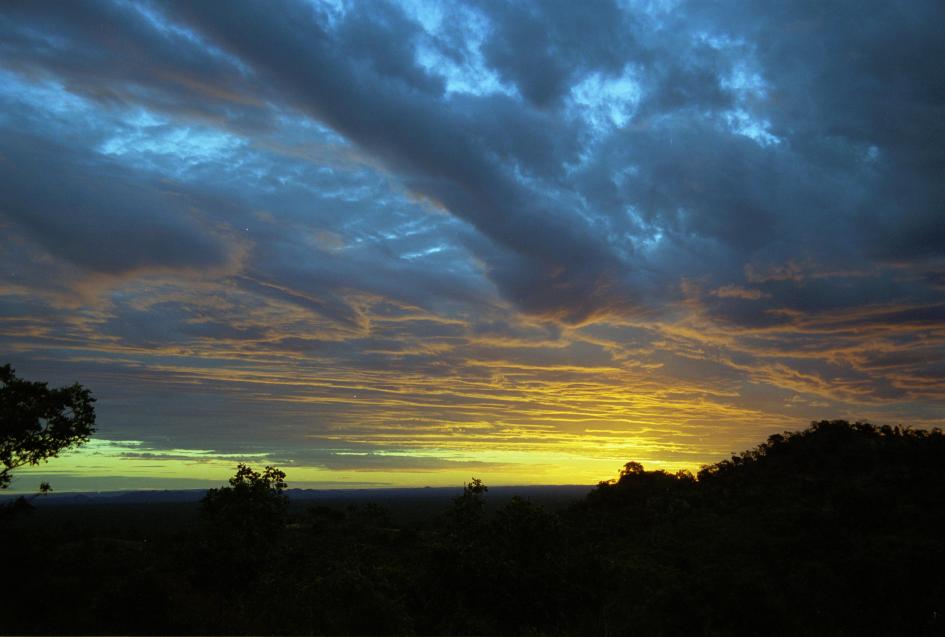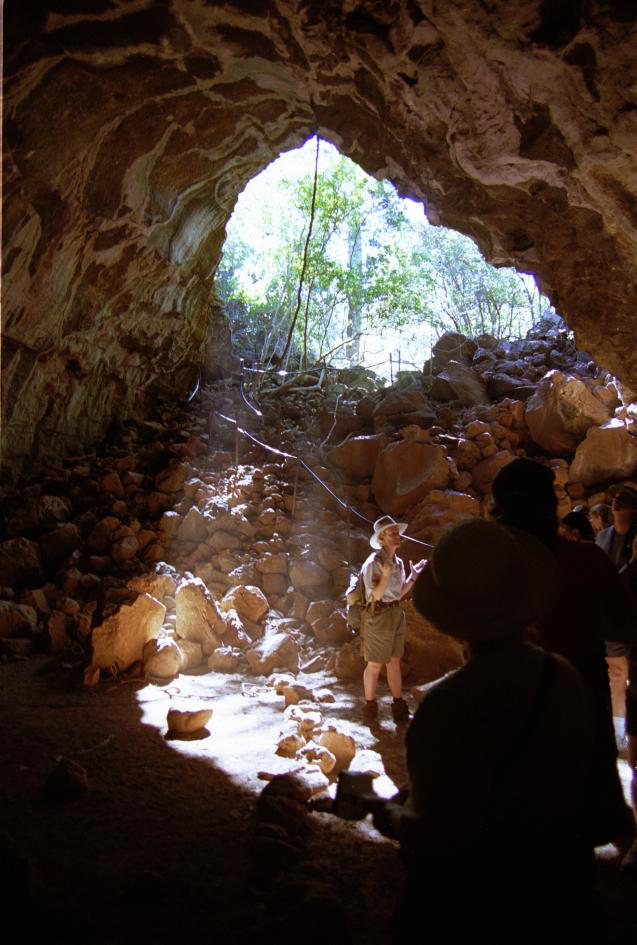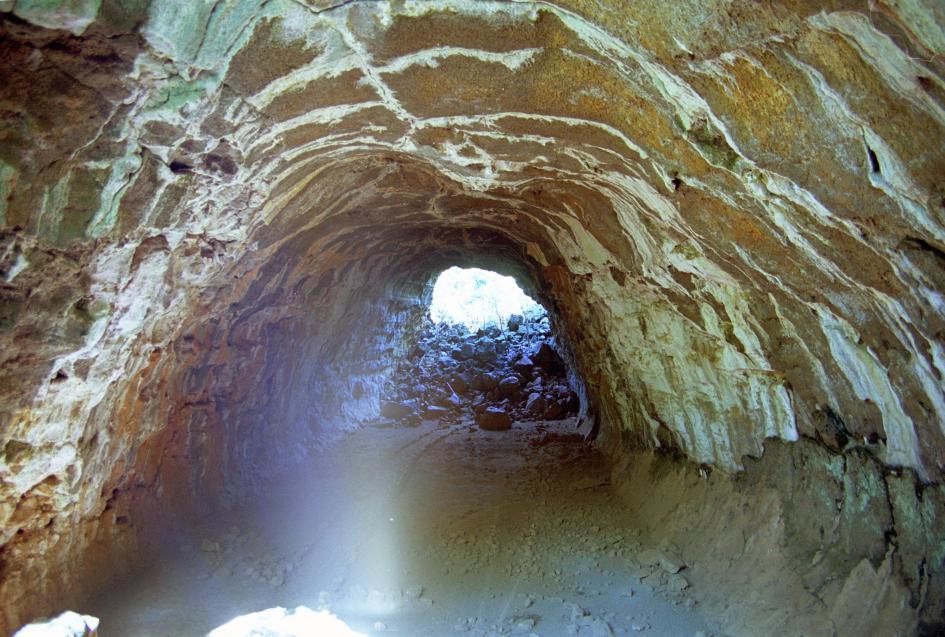5 May 2003: Brisbane, Australia
Subject: Australia
The Great Barrier Reef
The weather forecast was predicting a couple of days of better weather so I signed myself up for a boat trip out to the reef. It takes a couple of hours to get out so it's probably not something you want to do when the sea is very rough. We went out to Hastings Reef and stopped at two spots. The boat had both scuba divers, learners and certified divers, and casual snorkellers like me. The sea was quite warm, though not as hot as it had been in Tahiti and the Cook Islands and a wet suit would not be a bad idea. The top of the coral is quite shallow and then drops off vertically down to the realm of the divers. Compared to the other places that I've been there seemed to be more live coral with its polyps waving around, and I also saw a few sea ferns and other new things. There were lots of fish, mostly relatively big ones like parrot fish and wrasses and not so many of the shoals of lots of tiny fish that I've seen before. It was a good day out, but I think I prefered the snorkelling in the Pacific - it was more scenic there and you don't need to spend as long in a boat.
Undara Lava Tube Caves
The wet and stormy weather continued in Cairns and I decided to do some more inland trips rather than venturing out onto the high seas again. For some time I had been trying to decide the best way to see the lava tube caves at Undara, the problem being that they're quite a long way inland (about four hours drive), the local coach company (Coral Coaches) suddenly closed down recently and nobody knows if anyone else has taken over, and the train runs only once a week. I ended up on a fairly expensive two-day coach tour.
The first part of the journey out took the same route as Uncle Brian's platypus-spotting trip, though without the stops. There was quite a contrast between the styles of the two guides! For example, when we got to the small town of Malanda, this guide told us about the milk processing plant there and how it is one of the only dairy factories in the tropics and exports its milk as far as Darwin, Papua New Guinea, and even Singapore. On the other hand Uncle Brian pointed out the factory and said that his bus, "Gus The Bus", was in love with a milk lorry there and when we drove past and "she" wasn't there, Gus cried (with his windscreen washers). Take your pick.
This inland area, the Atherton Tablelands, is quite high up and that's why dairy farming is successful there; at sea level it would be too hot. Most of the forest has been cut down for pasture but some remains; it is either dense rainforest or much sparser eucalyptus forest featuring huge termite mounds. At Undara practically all of the ground cover is this sparse eucalyptus forest (or savannah), but in aerial photographs you can see small patches of rainforest. These remnants are in depressions resulting from lava tube roof collapses or in volcanic craters, and without this evidence it would be very hard to work out where the caves are.
Undara volcano errupted 160,000 years ago, but because this area has not been glaciated or otherwise significantly eroded the evidence of the erruption is still very much visible. The area is not at all hilly and it seems that the lava flow - three times the volume of Sydney harbour, apparently - followed the course of existing creek beds, reaching an incredible 160km from the crater. Having filled in these creek beds the land surface is now even flatter than it was before the erruption. The tube caves indicate the positions of these old creeks. They form where the surface of the lava flow cools and solidifies while the molten lava inside continues to flow; when the erruption stops the lava drains out, leaving a tube cave. Undara claims the longest lava flow in "recent" times (for some definition of recent!), though the individual tube segments here are much shorter than those in other parts of the world, most famously Hawaii where they are up to 25km long.
Our first sight of a tube was at dusk on the first evening when we had a look at a tube that is used as a bat roost. It was fairly impressive - the bats whisking past over our heads - and I wished that I had a bat detector with me! We also saw a shed snake skin hanging in a tree. Apparently the snakes sit in the trees and grab bats as they fly past! That would be an impressive sight. Here is a view of the sunset on the first evening, just before we went to see the bats:

There were about fifteen of us on this trip, about a dozen of them together. Quite why this lot had come I can't imagine - I'm the first to admit that my interest in things subterranean is not universally shared. This lot were horrified to find that their accommodation was not air conditioned, they had to share a bathroom, and that the place was full of spiders, snakes (only if you're lucky), bats and other creepy-crawlies. When we looked at this first hole of of them asked "So is this a lava tube them?". Then one of her friends went one better with "Is this man made?"!
The following morning we got to have a proper look at some tubes (though disappointingly we only spent about an hour underground over the whole two days). There were various interesting things to see, including more bats, this time a nursery where the bats roost together in a dense clump to conserve heat. There were various other bones on the cave floor and it is suggested that wallabies might come into these caves to die (rather than getting stuck in them and then dying). There are a few formations; some of them are post-formation features resulting from water seeping through bringing minerals with it, and others are "lavasicles" formed from molten rock running down the sides and dripping from the roof of the tube when it was still hot. But they are not as spectacular as limestone formations.
Here we are inside one of the tubes, our guide telling us something or other:

And here is a view of the roof of one of the tubes. Notice the darker colour of the volcanic rock and the whiter deposits where minerals have seeped through the roof:

There were various nature trails and other walks to do above ground and I saw a few more Australian animals, including the "pretty-faced wallaby" which has a white stripe along its cheek. There were also lots of cast insect skins on trees, and I didn't believe it when I was told that they are cicadas. I thought that cicadas were related to grasshoppers and made their noise with their legs. But it seems that these beetle-like things are indeed cicadas and, in Australia at least, they make their distinctive noise by vibrating their abdomens.
So after another four hours on a bus back to Cairns it was all over. I had had enough of Cairns by this time and decided to move on to Mission Beach, to the South, for a couple of days.
Tully River Rafting
You can't swim in the sea at Mission Beach at this time of year because of the jellyfish. (Out on the reef it's OK; the jellyfish are only a problem on the coast.) But there are plenty of other things to do - I signed up for a day rafting on the Tully River.
It was a good day; probably not quite as wild as the second of the two trips I did in Chile, but still quite exciting. There were a lot of boats there though and there was a fair bit of waiting around as the river guides took turns to stand "on guard" over the more difficult rapids. In Chile they were more efficient with extra people in canoes to do this safety duty. I think that normally the river is even more busy; the day that I went, the other company's bus had broken down on its way down from Cairns and their boats were being taken down empty!
To Brisbane by Train
For a bit of variety I decided to take the train from Tully down to Brisbane. It's quite a long way - about 1600km, which would take about 6 to 8 hours on a TGV. But here the trains go at a gentler pace and it takes 31 hours. That's an average speed of 54 km/h.
Although slow the train is comfortable; I had a sleeper and got probably the best night's sleep I've ever had on a train, thanks to the slow speed. There were also a couple of dining cars serving good and reasonably cheap freshly-cooked food. Although the coach does the trip a bit faster I think I'd still prefer the train for this reason.
The view from the train was interesting though there wasn't a lot of variety. There is quite a wide coastal plain all the way down and the railway and the road both go down the middle of it, out of sight of both the sea and the mountains. Some of the land is still forested with relatively sparse eucalyptus forest, but much of it has been cleared for cultivation (and is still being cleared where it is not protected). Most of it is used for sugar cane and trainspotters would love the narrow guage railways used to transport the cut cane from the fields to the mills. Most of the towns seem to be small places centred around the sugar mill. There is quite a lot of freight on the main line including tankers full of mollasses. Apart from the sugar there are a quite a lot of banana plantations and a few fields of pineapples. Apparently there are also mangoes but I didn't see any.
So now I'm in Brisbane and will be spending the day looking around here before moving on.
What's Next?
For some time I have been thinking about where to go next, and since the advice seems to change on an almost daily basis I have been putting off making any decisions. But finally I have to do something.
Frankly I doubt that the likelyhood of catching SARS or getting hijacked or bombed is as great as the chance of being hit by a car, but my main consideration is that my travel insurance requires me to follow any government advice. At the moment the UK Foreign Office is advising against all travel to Indonesia, a suggestion that was shown to be reasonably justified by a bomb in the KFC at Jakarta Airport a few days ago. They're also advising against travel to Hong Kong because of SARS, but say that transiting the airport is OK. Other places that have had SARS cases, including Singapore, are considered OK because there have been no cases of local transmission.
I did consider flying to Malaysia, but there are no flights that I can use from Australia to Kuala Lumpar. The next choice is to fly directly to Bangkok. From there I have the choice of either heading South to Malaysia overland, possibly flying to Sabah and Mount Kinabalu, or East to Cambodia and Vietnam. All of these places have great things to see and do, including fantastic coastlines especially in Thailand and Vietnam, lots of ancient temples like Angkor Wat in Cambodia, and a few mountains. So I have bought myself a couple of books and maps and got a flight to Bangkok for Friday. More news later. In the meantime if anyone has any suggestions for things to do in the areas I've mentioned, please let me know.